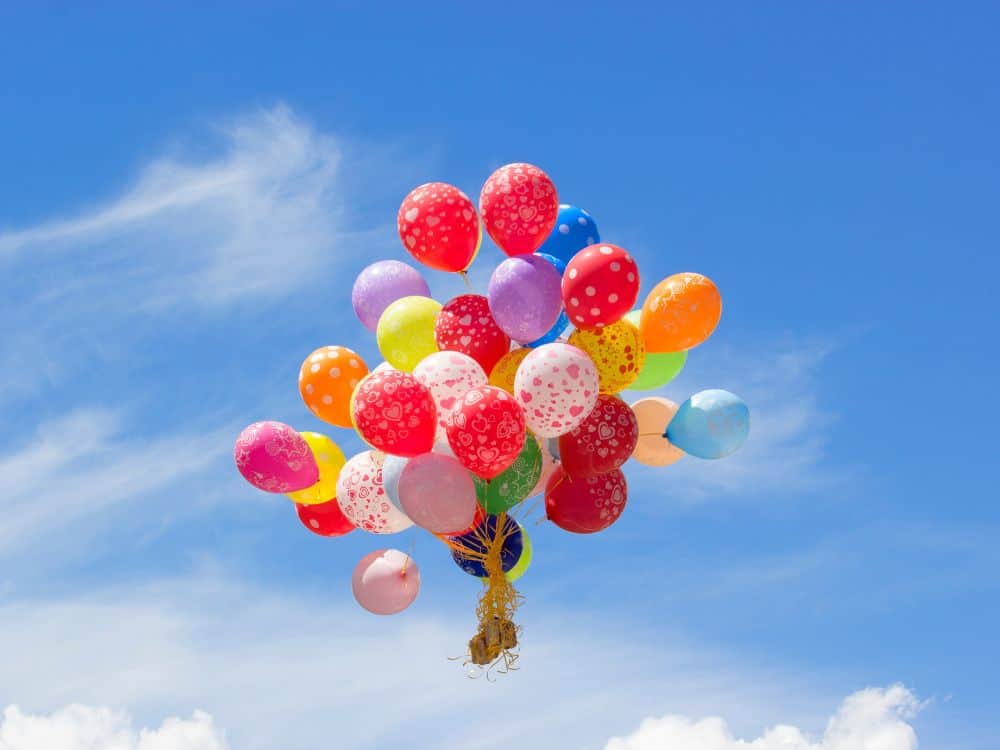
Biodegradable Balloons: Eco-Friendly Alternatives Or Gone Flat Greenwashing?
Biodegradable balloons have floated to the top as supposedly ‘sustainable balloon alternatives’.
But is it all just a load of hot air or do they really surpass traditional balloons?
The balloon industry has been deemed a party crasher by several states and cities that have limited planned balloon release events (where 12+ balloons are released).
With millions of balloons collectively released annually, celebrators have started to ask, “Are there balloons that are biodegradable?”
Are There Any Environmentally Friendly Balloons?
Unfortunately, the excitement around environmentally-friendly balloons has gone flat with the realization that biodegradable options aren’t so much biodegradable as they are environmental pollutants.
Even “fully biodegradable” balloons may add an unwanted splash of greenwashing to a pink and purple-themed birthday party.
While searches may fall short when looking for eco-friendly balloons to release, there are fortunately plenty of eco-friendly balloon alternatives that can keep the party going.
The Full List For Sustainable Balloons
- What are biodegradable balloons?
- Are biodegradable balloons really biodegradable?
- Are there eco-friendly balloons?
- Alternatives to biodegradable balloons
1. What Are Biodegradable Balloons?
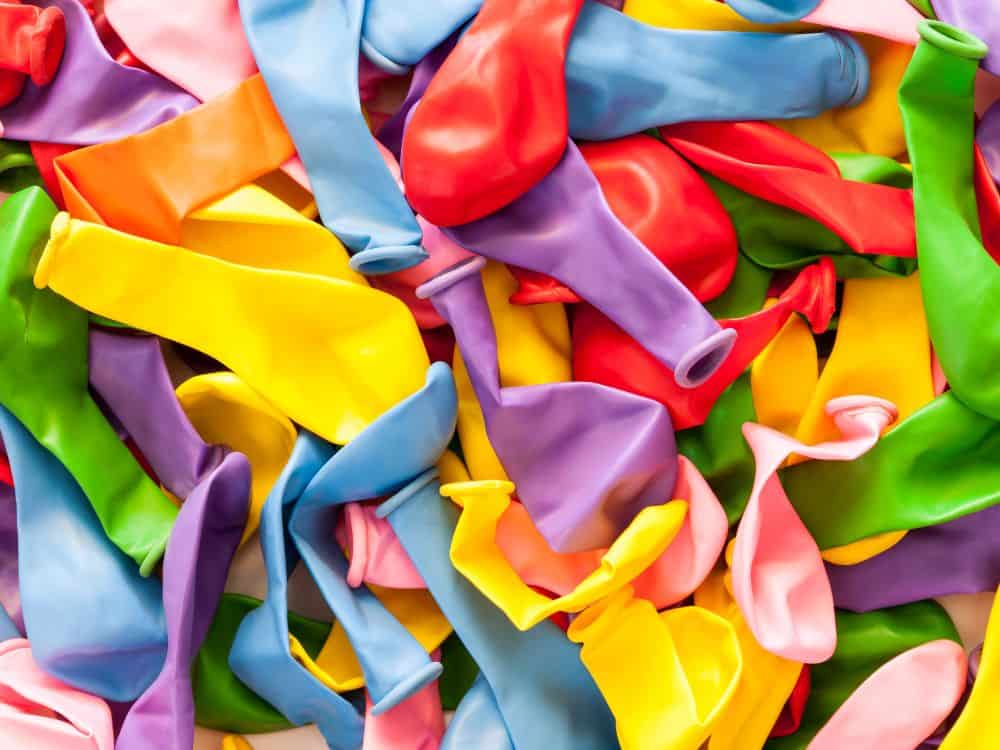
What goes up must come down. Do we really want bunches of helium-filled balloons ending up in the environment—especially knowing that they can travel more than 270 km (167 mi)?
For this reason (and more) many have turned to the biodegradable balloon as an alternative to those we’ve used since balloons were first manufactured in 1847.
What are biodegradable balloons made of?
Unfortunately, they look rather similar to the latex balloons we’re used to, and busting the myth that they’re anything special, they’re made with the same materials.
Latex balloons are made with natural latex, a type of rubber sap from the rubber tree (Hevea brasiliensis). This serves as a cruelty-free and (less gross) alternative to the animal bladder balloon of the past.
Aside from foil mylar (a polyester + aluminum film) balloons, most balloons on the market are made from or a blend of latex rubber, polychloroprene, vinyl, nylon fabric, and metalized plastic.
Can balloons be recycled?
With the list of balloon materials mentioned above (including some types of plastic), you might be wondering if there are recyclable balloons.
Unfortunately, a blend of latex, nylon, and other types of plastics has no value for a recycling center. The economics simply prevents balloons from being something they’d waste their time with.
Not to mention the absolute horror pieces of a popped balloon would present for a sorting machine.
While mylar foil has a slightly better fate, only a few recyclers (just three locations in the US) will accept them. But because they’re durable, they can be deflated and reinflated as reusable balloons.
2. Are Biodegradable Balloons Really Biodegradable?
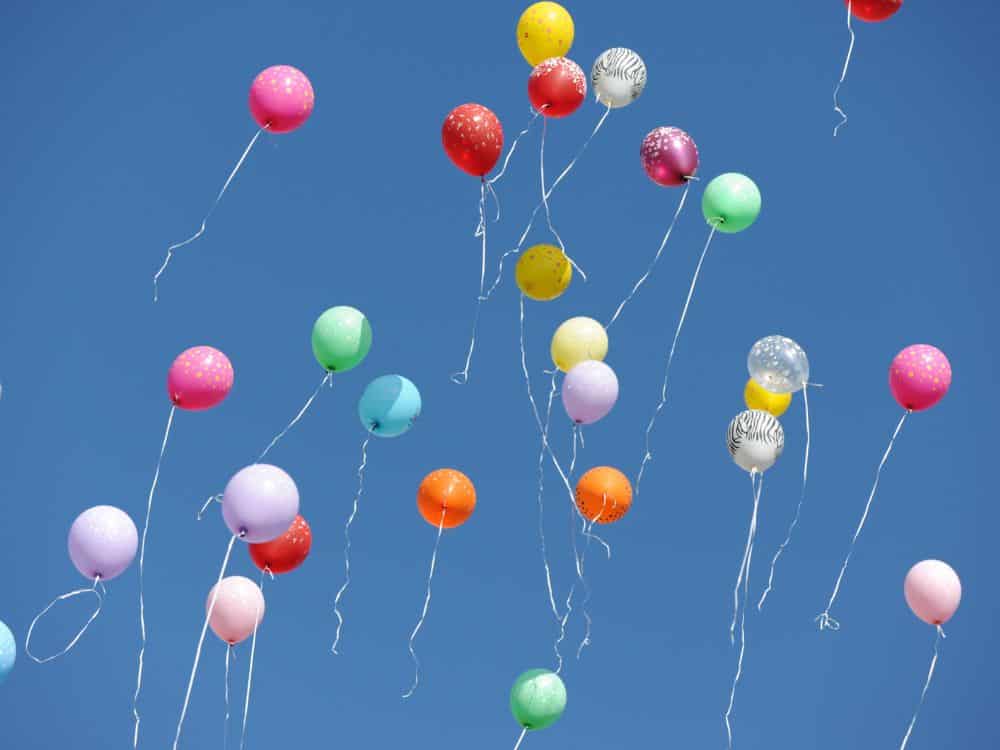
While using exclusively latex sounds like a greener alternative, biodegradable helium balloons might not be the environmentally safe balloons companies want us to think they are.
How long do biodegradable balloons take to decompose?
Watching them floating off into the environment, a thought may cross your mind: how long do biodegradable balloons last?
Just because we see them disappear into the sky after special occasions, it doesn’t mean they go away—even if supposedly biodegradable.
The nonprofit Balloons Blow has been conducting a lengthy experiment assessing the biodegradability of biodegradable, supposedly eco-friendly party balloons.
Taking samples that they found on the beach, they’ve continued to share images of two “eco-friendly” alternatives to balloons. Even after being exposed to torrential rains, intense sun, flooding, and other elements, the balloons remained intact—for seven years and counting!
Taking a more scientific approach, researchers published a 2021 study after investigating the fate of latex balloons in freshwater, marine, and composting environments.
For 16 weeks, the balloons retained their original shape and sizes—which also rules out compostable balloons—and for them to fully biodegrade, it would take an estimated 15 years or longer.
The study’s authors concluded that there was no meaningful degradation, “indicating that when released into the environment, they will continue to contribute to anthropogenic litter and pose a threat to wildlife”.
Are biodegradable balloons safe?
So, are balloons really biodegradable?
If this question was posed to the balloon industry, the answer would be a resounding “yes”.
They were behind a 1969 study that “demonstrated” that balloon releases were perfectly safe. Published by a Malaysian latex balloon manufacturer, findings concluded that helium-filled latex balloons would burst into small pieces, before eventually biodegrading at rates similar to that of an oak leaf.
Now, let’s burst the bubble (er, balloon).
Not only was the study never peer-reviewed, but it also didn’t take into consideration that while an oak leaf degrades in the natural environment, it poses no danger to wildlife.
The same can’t be said for a latex balloon—whether or not it’s made with pigment, coagulants (ammonia), and other chemicals.
3. Are There Eco-Friendly Balloons?
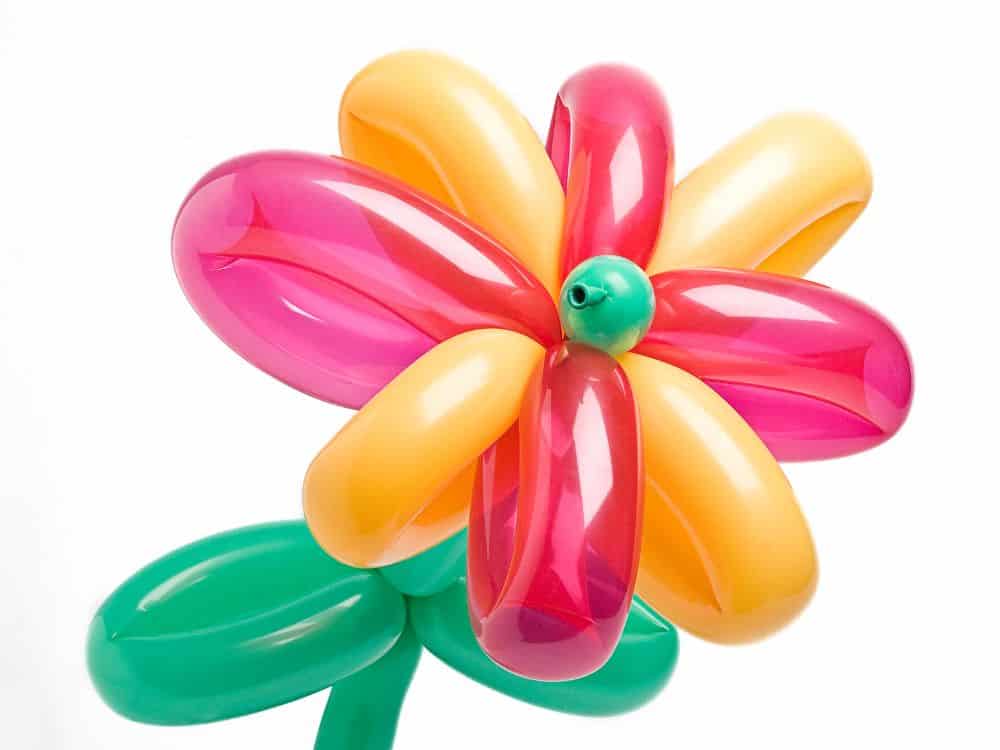
As a recap, are there biodegradable balloons?
No, not really, and even before they persist in the environment—harming willife and soil—balloons are manufactured (and filled) in ways that aren’t great for the planet, either.
What is the environmental impact of balloons?
- Materials: Natural latex rubber sounds innocent enough—but not when it’s treated with plasticizers, colors, and other potentially toxic ingredients (like vinyl chloride, a carcinogen).
- Manufacturing: Latex is vulcanized (to increase tensile strength) with sulfur and other compounds before it’s sieved to remove lumps and mixed with colored dye and more chemicals. Then a mold is dipped into a coagulant, then the latex. A machine presses the molds to make a balloon-shaped material which is washed and heated. Every step is energy/chemical intensive.
- Helium: You may have heard that there’s a worldwide helium shortage. The non-renewable gas is required for health applications, like running MRI machines. Kinda lets air out of the “need” for balloon releases, doesn’t it?
- Litter: Millions of balloons are released every year. They end up as ribbons wrapped around trees and as litter on beaches. In the US alone, it’s estimated that about 31,000 balloons are found on beaches annually.
- Marine life: Balloons and sky lanterns are a problem for wildlife, according to the Marine Conservation Society, who found an average of 3 balloons per 100m of shoreline—and in the stomachs of whales, seabirds, dolphins, and turtles.
Where can you buy biodegradable balloons?
Unaware of these impacts of “eco-friendly” options, many have asked, “What brand of balloons are biodegradable?”
We’ll start by saying that if you’re wondering where to buy biodegradable balloons, we’d recommend against them. See below for alternatives to biodegradable balloons for release.
Makers of eco balloons may claim “100% biodegradability” but are they actually? Are Bunch O Balloons biodegradable?
ZURU’s Bunch O Balloons—like those from other manufacturers—just don’t have the real-world evidence to demonstrate that they will naturally degrade.
Although the company had claimed that the “biodegradable and environmentally-friendly” leftover pieces could be left after a water balloon fight, there were skeptics (and FTC changes limiting the use of the term “biodegradability”).
Fast-forward a few years, and Bunch O Balloons no longer mentions biodegradability, instead saying their products “can be easily recycled through your regular recycling bins”, according to the ZURU website.
Recycling centers would say otherwise though, which is why the Bunch O BS also claimed that they started a recycling partnership with TerraCycle. Consumers could send their “biodegradable water balloons”, party balloons, stems, and packaging to TerraCycle for free.
Not to burst their balloon, but a broken sign-up link suggests this is no longer possible.
4. Alternatives To Biodegradable Balloons
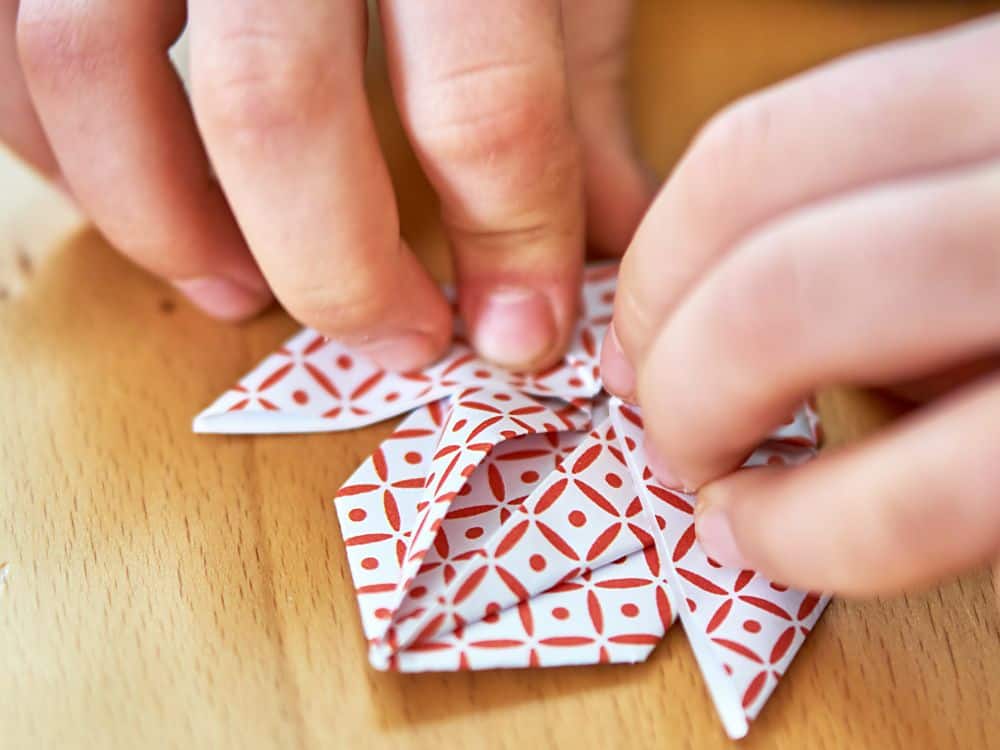
What to do to celebrate a birthday if biodegradable balloons are deemed un-eco-friendly?
The snacks from sustainable food brands have been purchased, you’ve thoughtfully scoured eco-friendly gifts to find something perfect, but you’re left with one important facet of the fun event: decor.
If you’ve found yourself asking, “What is an environmentally friendly alternative to helium balloons?”, we have some suggestions for you.
Environmentally friendly alternatives to balloons for decorations:
You can still create the blue-green-themed occasion for your kids’ end-of-school party—all with decorations that have a light impact on the earth.
- Pinwheels (made with recycled paper and paper straws)
- Homemade fabric bunting or flags (a great solution for what to do with old clothes)
- Ethically foraged items from nature (pinecones, leaves, fallen branches, flowers, etc.)
- DIY wildflower seed bombs
- Reusable luminaries with solar lights
- Origami (made with recycled paper)
Environmentally friendly balloon release alternatives:
While sky lanterns (AKA fire lanterns) have emerged as an eco-friendly alternative to balloons, they aren’t that great either.
While they can be made with paper, they often use a tea light to generate heat for flight. Most tea light candles are made with paraffin, a petroleum product that produces harmful byproducts (CO2).
Not to mention that they can cause environmental fires. Some better options include:
- DIY bubbles (zero-waste dish soap mixed with vegetable glycerin)
- Sustainable steamers and ribbons (like those used by ribbon dancers)
- Floating flowers down a stream
- Kites
- Biodegradable confetti (birdseed, flower petals, dried leaves)
Did you know we Have a Newsletter?
We cover the latest in sustainable living, fashion, zero waste, beauty, travel, finance and more…
Final Thoughts On Are Balloons Eco-Friendly?
Are there any environmentally friendly balloons?
No. If you see “compostable” water balloons, “eco-friendly” helium balloons, or any other type of “eco” balloons, run for the hills.
A kid’s event can still be fun without something that will float hundreds of miles, deflate in the natural environment, and create a problem for trees, soil, or seabirds that mistake it for food.
We wouldn’t (or at least shouldn’t) mindlessly throw out thousands of latex gloves, so why would we do the same with balloons?
Now that you know why biodegradable balloons are still not safe, spread the word to anyone planning a celebration. Just be sure to suggest some of the above balloon alternatives so as not to be a total party pooper.
Pin these:
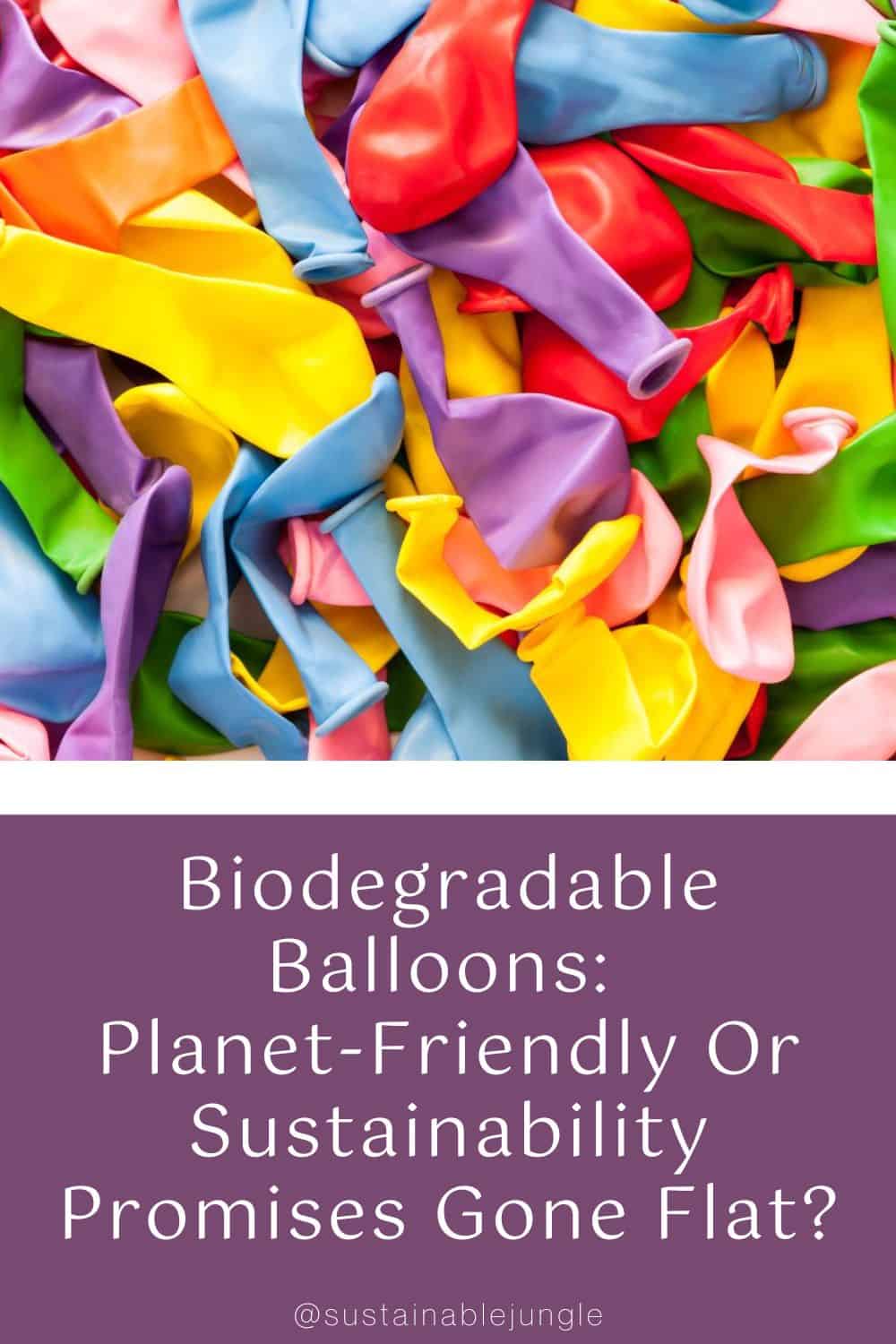
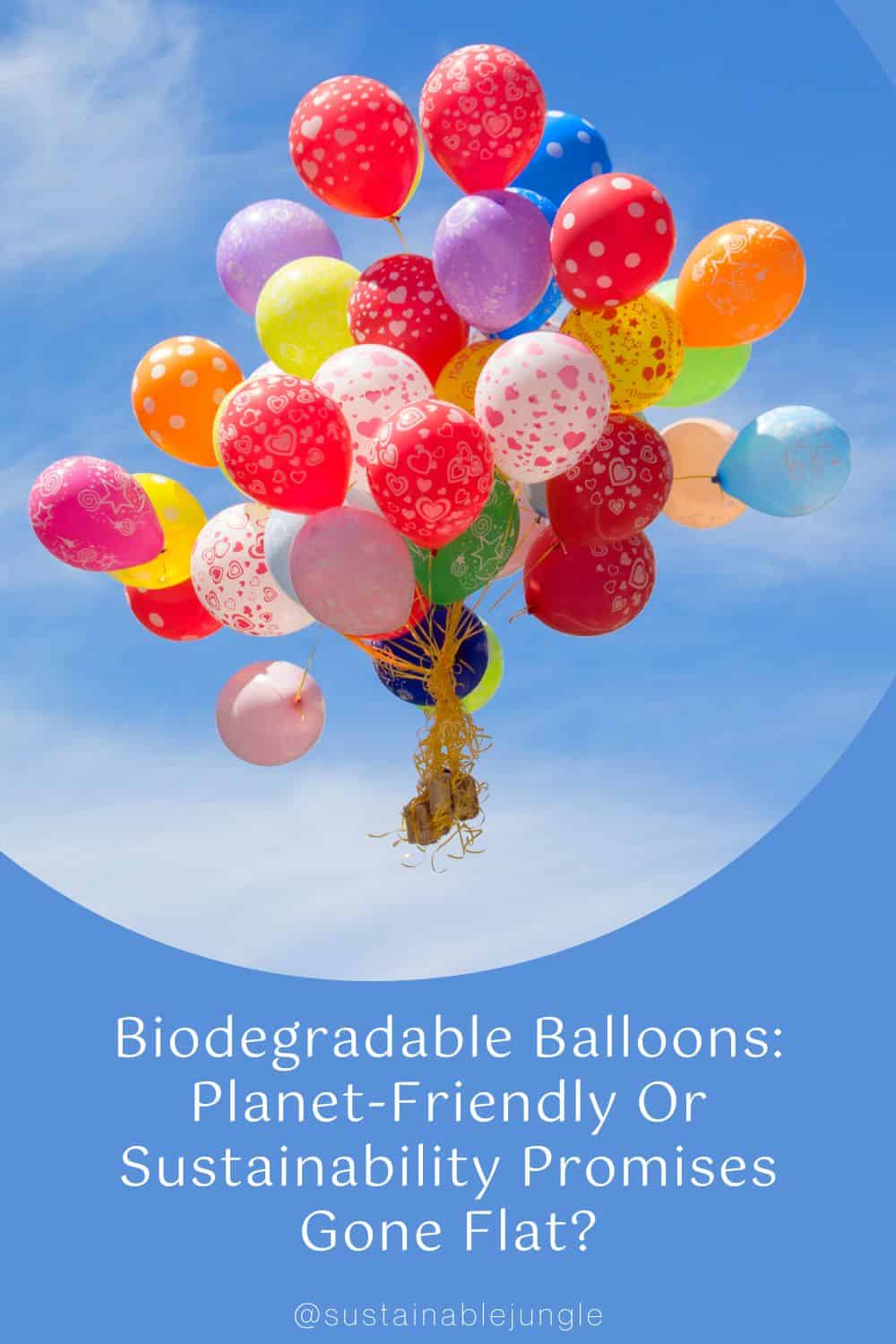

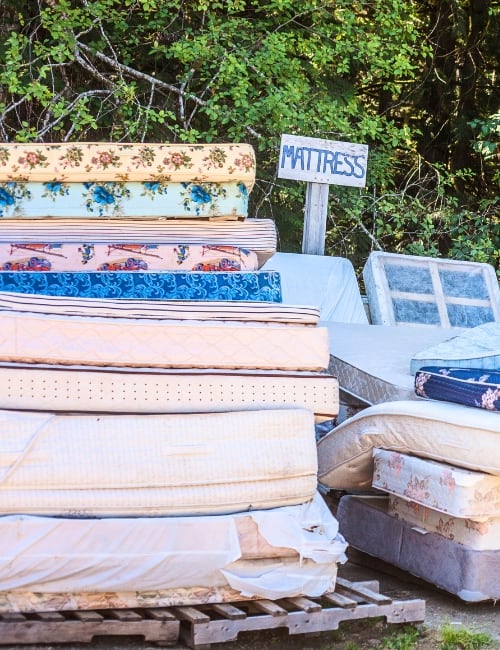
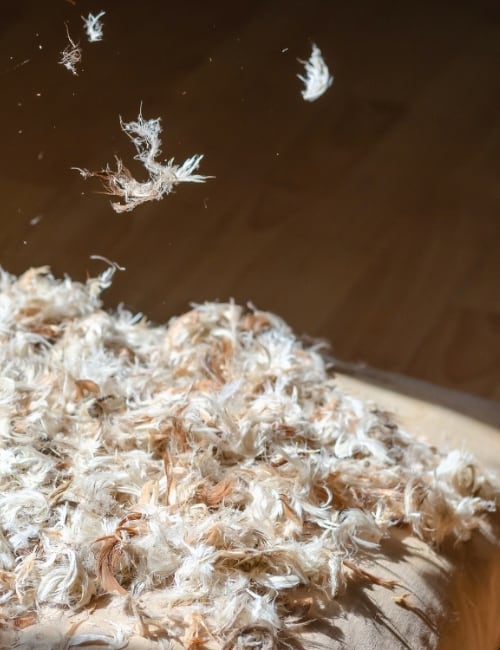

I’m against any kind of balloons and started making upcycled cloth decors. My son is a special child and he goes for sports training. In tennis it is very hard for our children to get hand eye coordination with even a soft ball, so the coach brought in balloons, blew them to a size that can be easy for our children and got them practicing tennis with the balloon. It worked very well. Now I’m really looking for alternatives. The coach definitely sees improvement in their hand eye coordination. I do too. So what to do in this case. Ofcourse it’s just 5 children but just using one balloon breaks my heart too. Instead of trashing the balloons I bring them back home.
Oh I feel that pain Poojitha, whenever we go to (other) kids parties, there are balloons and my kid loves them. It’s hard to deny them sometimes! In the case of the tennis, maybe some large blow up and reusable beach balls would work?